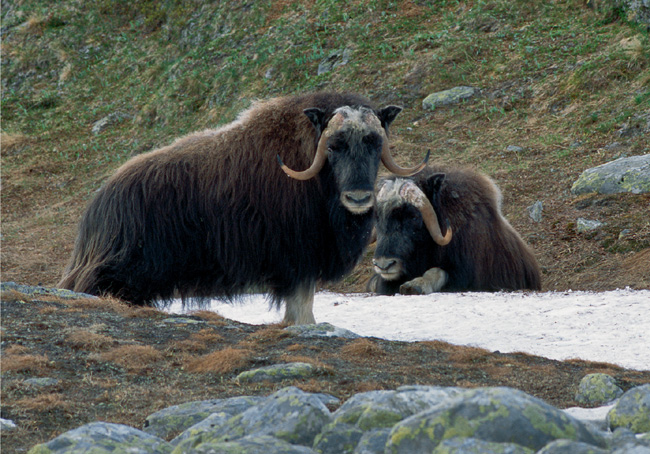
Ovibos moschatus
Musk Ox is a polar animal, introduced from northeastern Greenland to the Dovrefjell-Rondane region of Norway, from which it has expanded into the Härje valley in Sweden.
It is related to sheep and goats and has a compact body with a small hump above the shoulders, a large, wide head, large dark eyes, and small pointed ears, almost completely covered by fur. The tail is very small and covered by fur.
The animal is covered with coarse hair, up to 50 cm long, that reaches its feet; beneath this it has a lighter, softer undercoat that can be spun into threads like sheep’s wool. Musk Ox is dark brown with large white spots on its back and lighter-coloured legs, snout, and forehead. The snout is hairy, and the fur reaches even below the hooves.
Musk Ox is 1.8–2.3 m long, 1.2–1.5 m at the shoulder, and weighs 200–350 kg; the male is larger.
When it’s too warm, female Musk Oxen gladly rest in snow. AK.

Both sexes have large horns, which are broader and rougher at the base. In old males, the horns can cover the entire forehead; females have a light, hair-covered area between the horns. The horns point downwards and forward and have pointed tips.
Musk Oxen live in herds. During the mating season, from August to October, the sexually mature bulls fight for females; in the process, the dominant bull banishes the others. The bulls stand with lowered heads facing each other and ram the opponent’s head with such force that clashes echo in surrounding mountains. In May or June, the cow gives birth to a calf, more rarely two, and cares for it for 18 months; a calf becomes sexually mature at 4 years of age.

Musk Ox hair can often be found on bushes and trees. LG.

The tracks can be confused with those of Reindeer. Musk Ox footprints are almost circular, and the single hoof print is kidney-shaped, 8–11 cm long. The hooves are somewhat asymmetrical, since the outer hoof is slightly larger and rounder than the inner, which is a little more pointed. The stride is 80–120 cm, and the legs are splayed far more than is the case with Reindeer.
You will get to see prints of dew claws only in deep snow, and they are closer together than in a Reindeer footprint. If threatened, Musk Oxen will run very fast, with a stride between 2.5 and 3.5 m; the hoofs are not splayed when running.
Musk Ox scat. LG.

Musk Ox tracks in mud. LG.

The animals feed on young willow shoots, grass, herbs, moss, and lichens. Their scat lies in small mounds and resembles that of Reindeer, but is somewhat larger, slick, and more oval, 1.5–2 cm long and about 1 cm thick. In summer the scat is more cohesive and more angular in shape.
You almost always find scat together with some of the animal’s long hair. Musk Oxen lose a good portion of their coat in summer, and you can find large tufts of the undercoat on the ground or in bushes and trees.
Beware! Musk Oxen are very shy when interacting with humans, but you should still keep a safe distance. If the herd gathers in a semicircular formation, and the bulls begin to snort, stamp on the ground, or tear up plants and stones with their horns, you have come too close and should move away immediately.